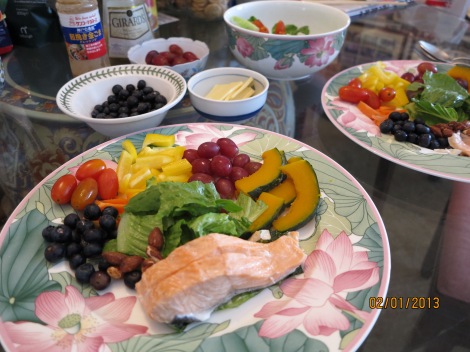
Lurking Dangers In Adulterated, Contaminated, Poisoned Foods And Counterfeits
I just had my lunch. It was not a horse meat beefburger for sure. Mindful of the current horse-meat-in-beefburgers scandal, I prepared my lunch which is similar to the picture shown! It was a healthy salad with fresh fruit and vegetables, steamed tofu and steamed salmon. Now I am energised to write about adulterated, contaminated and poisoned foods. And yes, I am adding counterfeit foods too! Please do educate yourself and be aware of the lurking dangers surrounding the stuff you eat if you want to live healthy and retire healthy.
Adulterated, Contaminated And Poisoned Foods…
Come on Wikipedia, you only have a scanty write-up on adulterated food! This is a topic that can mean life and death. Adding ingredients to make food items bulkier, more appealing and tastier and thereby pushing up sales are common practices in the food industry. Substituting inferior and cheaper ingredients for the main food items is driven by economic gains and profits. I wish I could use the past tense in both these sentences.
The fight against food adulteration began with the pioneering work started by chemist Frederick Accum and medic Arthur Hill Hassall in 19th century England. Up until 1875, food packages and canned and bottled drinks were not required by law to specify their contents. The fight goes one. In the United States, the Food and Drug Administration (FDA) laments that the "sheer magnitude of the potential crime" makes prevention difficult, along with the fact that food safety is not treated as a high priority. For Europe, it is seen as a serious threat.
The Most Adulterated Foods…

Even today, the most adulterated food items are olive oil, milk and honey. Other top adulterated food items include orange juice, coffee and apple juice. So your extra-virgin olive oils can contain cheaper corn oil, hazel nut or palm oil. Or they could be up to 90% soybean oil. The adulteration of food items using cheaper and inferior substitutes continues to underpin the greed of the unscrupulous players in the food industry.
Contaminated foods result from the presence of pathogenic bacteria, viruses, or parasites that contaminate food, as well as chemical or natural toxins. Food poisoning often results from eating contaminated foods. Salmonella is the most common bacteria which cause food poisoning, especially in eggs. There is always the chance of contamination in food during all the stages of its production and retailing. Proper handling, storage and processing can be incorporated into all aspects of food safety to minimise the contamination in foods.
In the current scandal involving the discovery of millions of British and Irish beefburgers with horse meat and pig DNA, answers need to be found to shore up breaches to food safety. Whilst small traces of horse and pig DNAs in the beefburgers might be termed contaminated burgers, the 29.1% of horse meat found in Tesco's Everyday Value Beef Burgers must be a clear adulteration. To its credit, Tesco has admitted that criminality or gross negligence has almost certainly been involved.
Poisoned foods, a category which I'd like to add for those food items where the adulteration was intentional and known to cause harm, either for profit motive or, worse still, for sinister intentions. The 1984 Rajneeshee bioterror attack during which hundreds suffered food poisoning through the deliberate contamination of salad bars at ten local restaurants in Oregon, USA with salmonella. Then the notorious milk scandals in China, in 2008 and again in 2012, the latter involving baby formula.
Lastly, there are the Counterfeit foods where fakes, usually of more expensive items, were made for sale to the general market. Tea and coffee were popular fakes.
I hope this post will help you be more aware of the dangers that lurk in adulterated, contaminated, poisoned and counterfeit foods. Stay healthy…
Related Articles :
- The Most Adulterated Food Products: Olive Oil, Milk, Honey And More~ Huffington Post
- Safety concerns emerge over horse DNA in supermarket beef ~ The Guardian
- The cost of cheap meat : The Telegraph
- The fight against food adulteration : The Royal Society of Chemistry
More Related Articles :
- Group Finds More Fake Ingredients in Popular Foods (madeinusanews.com)




[…] Lurking Dangers In Adulterated, Contaminated, Poisoned Foods And Counterfeits (retiredowhat.wordpress.com) […]
The more you learn about food adulterations and contaminations, the more you can safeguard yourself and your family. Unscrupulous merchants in the food industry have existed since times gone by, so don’t be ignorant.